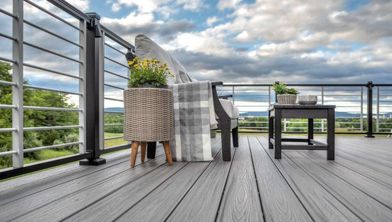How To Choose A Deck Colour That Complements Your Home
Decking colours aren’t merely another chance to personalise your deck, they’re a defining feature of its total presentation. And what looks great for someone else’s deck, won’t necessarily look great for yours. Determining the best deck colours needs to be done on a case-by-case basis, incorporating a broader understanding of several interrelated variables.
While picking colours is a science, it’s not rocket science. Whether you’re looking for natural looking composite decking or something a little more modern, below you can learn a few essential tips, guidelines, and ideas to help you choose the best composite colours for your outdoor space.
Identifying Complementary Decking Colours
Beauty is in the eye of the beholder, but the science of colour can help guide you towards making optimal decisions for your objectives and environment. Because of the various relationships between colours, the most common colour groups for decking are currently grey, brown, and red. And within those groups you also find an extensive range of undertones and hues.
Here are some basic tips to help you choose colours to complement your home:
- A white home will match with decking of nearly any colour scheme
- Blue, red, or grey exterior tends to complement grey decking
- Brown decking is neutral, making it a safe choice for nearly all colours
Trex Decking Colour Options
From the warm reddish hues of Lava Rock to the neutral grey-silver of Foggy Wharf, Trex has an extensive range of colour options. With both warm and cool colours appropriate for a modern or traditional aesthetic, Trex can provide colours to complement virtually any environment.
If you’re still dreaming up ideas, you can browse the Lookbook to explore what those options look like. And if you’re ready to start your project, you can find merchants in your area.
Tips for Picking the Perfect Trex Deck Colour
For generations, the most common decking colours have mostly been variations of brown. However, modern colour trends are favouring grey for a more contemporary look. It’s equally important to observe undertones. Another easily overlooked design consideration is colour temperature; warmer colours (orange, red, yellow) have distinct undertones from cooler colours like green and blue.
Even neutrals, like grey, usually have a warmer or cooler undertone that will either complement or clash with its environment. You can use the colour selector to help you explore how some of those options look in a real world scenario.
1. Don’t Choose an Exact Match
Avoiding an exact colour match will prevent your exterior from ending up monotone and visually boring. If you prefer to keep things simple, try to find colour complements which are appropriate for the dominant colour of your home. Those can be direct colour complements, tertiary colour complements, or others.
2. Create Flow
The colour of your home is one part of the picture, but you’ll also want to think about the colour of the broader environment. How do your colour choices pair with the dominant colours of the scenery around your deck? For instance, if you’re in a densely wooded area surrounded with lush greenery, you may want to consider colours that will complement green.
3. Consider Climate
White composite decking will heat slower than black composite decking. It will also cool down slower. If your deck receives full sun exposure over the course of the day, you might be better off selecting a lighter colouration, especially if you anticipate bare feet on your deck. With limited sun exposure, this factor becomes less of a concern.
4. Order Samples
The colours you view on a digital display are rarely true-to-life. Even when they are, variables like lighting conditions can have a big impact on the presentation of a colour. Samples are the most reliable way to ensure you know precisely what a colour really looks like.
Example Deck Colour Combinations
If you’re not looking to reinvent the wheel, some simple and effective deck colour ideas include:
- Combine a warmer brown (like Tiki Torch) with cooler whites or blues. Cooler blues harmonise with warmer browns for a peaceful ambiance often found in coastal cities.
- Teak composite decking complements exceptionally well with green. But pay attention to the undertones of the material; teak with yellow undertones pairs especially well with blue and yellow
- Combine a cool brown and a warm brown for a classic two-toned deck. This no-nonsense combination makes use of all neutral colours, allowing it to work well in most environments, modern and rustic alike.
- Grey composite decking with cooler undertones, (like Gravel Path), harmonises well with warmer browns and greys. As a neutral tone, grey pairs well with many colours, helping ensure it’s typically one of the safest colour selections you can make.
- Walnut composite decking also goes great with grey. And combining two neutral colours allows you to decorate the remainder of your deck with essentially an unlimited range of colour options without clashing.
Get Started Building Your Deck Today
Getting colours aligned properly is more than an important detail, it can have an enormous impact on the presentation of your deck. Trex offers an extensive variety of high-quality colour and style options, so you can find the right material for nearly any project.
If you’re ready to get started, order your free sample kit today.
This content was partially or fully generated by AI and has been reviewed by our team to ensure accuracy and relevance.




































